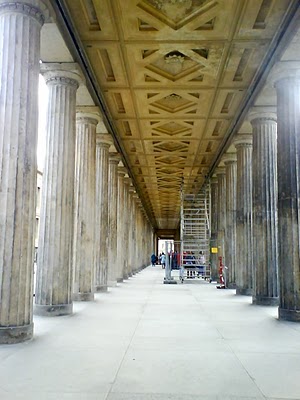I was used to the Museum Island as building site. The edifices were interiors, not exteriors. You negotiated your way around scaffolding and plastic sheeting to find the entrance to a collection. The island was remarkably quiet for being Berlin’s most ambitious restoration project. Somewhere, behind the barriers, a couple of workers silently laid one brick at a time, or so I imagined–results expected next millennium.
The sheeting recently came down from the colonnades that line the island’s banks. It was a 20 million Euro project largely hidden from view. I was on the S-Bahn train from Hackesche Markt when I saw the elegant ribbon of columns stretch out, and then withdraw. I looked back dumb with surprise as we passed over the island track, sculptures and antiquities blinking at me through the windows of the museums.
I got off at Friedrichstraße and walked back to inspect the sudden change.
These colonnades were my first exposure to WW2 damage in the capital when I arrived here in 1999. The garden space between them was a pile of debris. Friedrich August Stühler’s 1841 designs had crumbled into the Roman ruins they imitated –but by an erosion of bullets. The surface of the pillars was shaped by metallic wind, one could decipher the direction of the blast. Three of the cupolas had been decimated. It seemed an epitaph on Germany’s romance with the Classical world.
And now, within a couple of months, it will be possible to visit the museums of the ‘German Louvre’ through these connecting corridors. War damage and DDR neglect is repaired. The frames of the colonnade look out to the river, the passing train, the mix of Imperial, Socialist, and shabby contemporary architecture beyond. I imagine a man in hospital who can breathe, think, eat, and all at once, suddenly, without expecting, finds that he can also walk.

